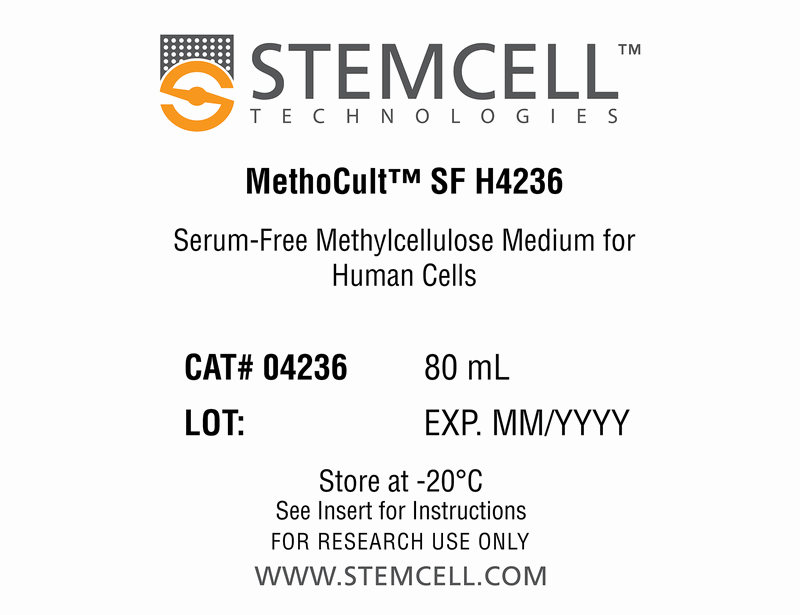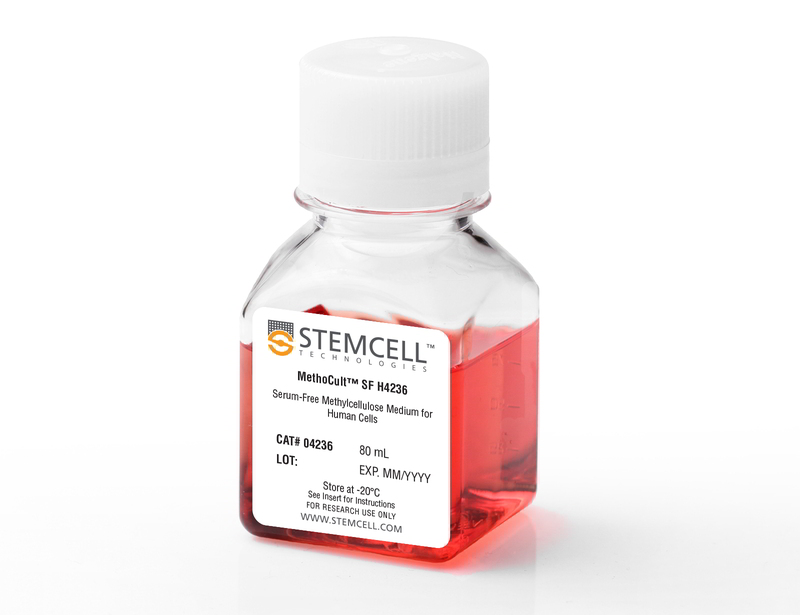概要
MethoCult™ SF H4236 is a serum-free, incomplete methylcellulose-based medium for the growth and enumeration of hematopoietic progenitor cells in colony-forming unit (CFU) assays of human bone marrow, mobilized peripheral blood, peripheral blood, and cord blood samples. This formulation does not contain fetal bovine serum, erythropoietin (EPO) or other cytokines and is recommended for testing cytokines and other supplements where the presence of serum is not desired.
Browse our Frequently Asked Questions (FAQs) on performing the CFU assay and explore its utility as part of the cell therapy workflow.
Browse our Frequently Asked Questions (FAQs) on performing the CFU assay and explore its utility as part of the cell therapy workflow.
技术资料
| Document Type | 产品名称 | Catalog # | Lot # | 语言 |
|---|---|---|---|---|
| Product Information Sheet | MethoCult™ SF H4236 | 04236 | All | English |
| Manual | MethoCult™ SF H4236 | 04236 | All | English |
| Safety Data Sheet | MethoCult™ SF H4236 | 04236 | All | English |
数据及文献
Publications (12)
Pharmacological research 2020 jan
A novel class of cardioprotective small-molecule PTP inhibitors.
Abstract
Abstract
Ischemia/reperfusion (I/R) injury is mediated in large part by opening of the mitochondrial permeability transition pore (PTP). Consequently, inhibitors of the PTP hold great promise for the treatment of a variety of cardiovascular disorders. At present, PTP inhibition is obtained only through the use of drugs (e.g. cyclosporine A, CsA) targeting cyclophilin D (CyPD) which is a key modulator, but not a structural component of the PTP. This limitation might explain controversial findings in clinical studies. Therefore, we investigated the protective effects against I/R injury of small-molecule inhibitors of the PTP (63 and TR002) that do not target CyPD. Both compounds exhibited a dose-dependent inhibition of PTP opening in isolated mitochondria and were more potent than CsA. Notably, PTP inhibition was observed also in mitochondria devoid of CyPD. Compounds 63 and TR002 prevented PTP opening and mitochondrial depolarization induced by Ca2+ overload and by reactive oxygen species in neonatal rat ventricular myocytes (NRVMs). Remarkably, both compounds prevented cell death, contractile dysfunction and sarcomeric derangement induced by anoxia/reoxygenation injury in NRVMs at sub-micromolar concentrations, and were more potent than CsA. Cardioprotection was observed also in adult mouse ventricular myocytes and human iPSc-derived cardiomyocytes, as well as ex vivo in perfused hearts. Thus, this study demonstrates that 63 and TR002 represent novel cardioprotective agents that inhibit PTP opening independent of CyPD targeting.
Cell stem cell 2019 aug
Interconversion between Tumorigenic and Differentiated States in Acute Myeloid Leukemia.
Abstract
Abstract
Tumors are composed of phenotypically heterogeneous cancer cells that often resemble various differentiation states of their lineage of origin. Within this hierarchy, it is thought that an immature subpopulation of tumor-propagating cancer stem cells (CSCs) differentiates into non-tumorigenic progeny, providing a rationale for therapeutic strategies that specifically eradicate CSCs or induce their differentiation. The clinical success of these approaches depends on CSC differentiation being unidirectional rather than reversible, yet this question remains unresolved even in prototypically hierarchical malignancies, such as acute myeloid leukemia (AML). Here, we show in murine and human models of AML that, upon perturbation of endogenous expression of the lineage-determining transcription factor PU.1 or withdrawal of established differentiation therapies, some mature leukemia cells can de-differentiate and reacquire clonogenic and leukemogenic properties. Our results reveal plasticity of CSC maturation in AML, highlighting the need to therapeutically eradicate cancer cells across a range of differentiation states.
Stem Cell Reports 2014 DEC
Tenascin C promotes hematoendothelial development and T lymphoid commitment from human pluripotent stem cells in chemically defined conditions
Abstract
Abstract
The recent identification of hemogenic endothelium (HE) in human pluripotent stem cell (hPSC) cultures presents opportunities to investigate signaling pathways that are essential for blood development from endothelium and provides an exploratory platform for de novo generation of hematopoietic stem cells (HSCs). However, the use of poorly defined human or animal components limits the utility of the current differentiation systems for studying specific growth factors required for HE induction and manufacturing clinical-grade therapeutic blood cells. Here, we identified chemically defined conditions required to produce HE from hPSCs growing in Essential 8 (E8) medium and showed that Tenascin C (TenC), an extracellular matrix protein associated with HSC niches, strongly promotes HE and definitive hematopoiesis in this system. hPSCs differentiated in chemically defined conditions undergo stages of development similar to those previously described in hPSCs cocultured on OP9 feeders, including the formation of VE-Cadherin(+)CD73(-)CD235a/CD43(-) HE and hematopoietic progenitors with myeloid and T lymphoid potential.
PloS one 2008 JAN
Drug-selected human lung cancer stem cells: cytokine network, tumorigenic and metastatic properties.
Abstract
Abstract
BACKGROUND: Cancer stem cells (CSCs) are thought to be responsible for tumor regeneration after chemotherapy, although direct confirmation of this remains forthcoming. We therefore investigated whether drug treatment could enrich and maintain CSCs and whether the high tumorogenic and metastatic abilities of CSCs were based on their marked ability to produce growth and angiogenic factors and express their cognate receptors to stimulate tumor cell proliferation and stroma formation. METHODOLOGY/FINDINGS: Treatment of lung tumor cells with doxorubicin, cisplatin, or etoposide resulted in the selection of drug surviving cells (DSCs). These cells expressed CD133, CD117, SSEA-3, TRA1-81, Oct-4, and nuclear beta-catenin and lost expression of the differentiation markers cytokeratins 8/18 (CK 8/18). DSCs were able to grow as tumor spheres, maintain self-renewal capacity, and differentiate. Differentiated progenitors lost expression of CD133, gained CK 8/18 and acquired drug sensitivity. In the presence of drugs, differentiation of DSCs was abrogated allowing propagation of cells with CSC-like characteristics. Lung DSCs demonstrated high tumorogenic and metastatic potential following inoculation into SCID mice, which supported their classification as CSCs. Luminex analysis of human and murine cytokines in sonicated lysates of parental- and CSC-derived tumors revealed that CSC-derived tumors contained two- to three-fold higher levels of human angiogenic and growth factors (VEGF, bFGF, IL-6, IL-8, HGF, PDGF-BB, G-CSF, and SCGF-beta). CSCs also showed elevated levels of expression of human VEGFR2, FGFR2, CXCR1, 2 and 4 receptors. Moreover, human CSCs growing in SCID mice stimulated murine stroma to produce elevated levels of angiogenic and growth factors. CONCLUSIONS/SIGNIFICANCE: These findings suggest that chemotherapy can lead to propagation of CSCs and prevention of their differentiation. The high tumorigenic and metastatic potentials of CSCs are associated with efficient cytokine network production that may represent a target for increased efficacy of cancer therapy.
Blood 2006 MAY
Synergistic activity of the proteasome inhibitor PS-341 with non-myeloablative 153-Sm-EDTMP skeletally targeted radiotherapy in an orthotopic model of multiple myeloma.
Abstract
Abstract
Multiple myeloma is a highly radiosensitive skeletal malignancy, but bone-seeking radionuclides have not yet found their place in disease management. We previously reported that the proteasome inhibitor PS-341 selectively sensitizes myeloma cells to the lethal effects of ionizing radiation. To extend these observations to an in vivo model, we combined PS-341 with the bone-seeking radionuclide 153-Sm-EDTMP. In vitro clonogenic assays demonstrated synergistic killing of myeloma cells exposed to both PS-341 and 153-Sm-EDTMP. Using the orthotopic, syngeneic 5TGM1 myeloma model, the median survivals of mice treated with saline, 2 doses of PS-341 (0.5 mg/kg), or a single nonmyeloablative dose of 153-Sm-EDTMP (22.5 MBq) were 21, 22, and 28 days, respectively. In contrast, mice treated with combination therapy comprising 2 doses of PS-341 (0.5 mg/kg), 1 day prior to and 1 day following 153-Sm-EDTMP (22.5 MBq) showed a significantly prolonged median survival of 49 days (P textless .001). In addition to prolonged survival, this treatment combination yielded reduced clonogenicity of bone marrow-resident 5TGM1 cells, reduced serum myeloma-associated paraprotein levels, and better preservation of bone mineral density. Myelosuppression, determined by peripheral blood cell counts and clonogenicity assays of hematopoietic progenitors, did not differ between animals treated with 153-Sm-EDTMP alone versus those treated with the combination of PS-341 plus 153-Sm-EDTMP. PS-341 is a potent, selective in vivo radiosensitizer that may substantially affect the efficacy of skeletal-targeted radiotherapy in multiple myeloma.
Blood 2004 SEP
Extracellular nucleotides are potent stimulators of human hematopoietic stem cells in vitro and in vivo.
Abstract
Abstract
Although extracellular nucleotides support a wide range of biologic responses of mature blood cells, little is known about their effect on blood cell progenitor cells. In this study, we assessed whether receptors for extracellular nucleotides (P2 receptors [P2Rs]) are expressed on human hematopoietic stem cells (HSCs), and whether activation by their natural ligands, adenosine triphosphate (ATP) and uridine triphosphate (UTP), induces HSC proliferation in vitro and in vivo. Our results demonstrated that CD34(+) HSCs express functional P2XRs and P2YRs of several subtypes. Furthermore, stimulation of CD34(+) cells with extracellular nucleotides caused a fast release of Ca(2+) from intracellular stores and an increase in ion fluxes across the plasma membrane. Functionally, ATP and, to a higher extent, UTP acted as potent early acting growth factors for HSCs, in vitro, because they strongly enhanced the stimulatory activity of several cytokines on clonogenic CD34(+) and lineage-negative CD34(-) progenitors and expanded more primitive CD34(+)-derived long-term culture-initiating cells. Furthermore, xenogenic transplantation studies showed that short-term preincubation with UTP significantly expanded the number of marrow-repopulating HSCs in nonobese diabetic/severe combined immunodeficiency mice. Our data suggest that extracellular nucleotides may provide a novel and powerful tool to modulate HSC functions.

 网站首页
网站首页



